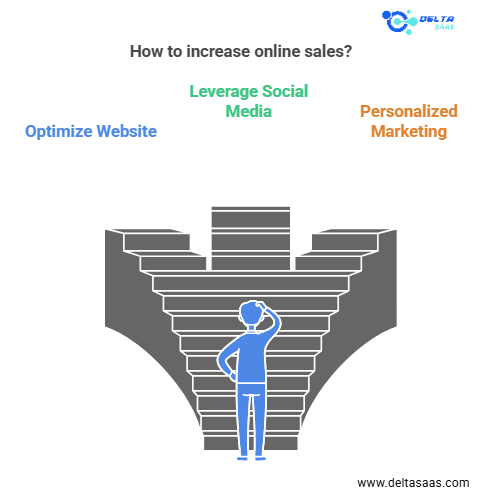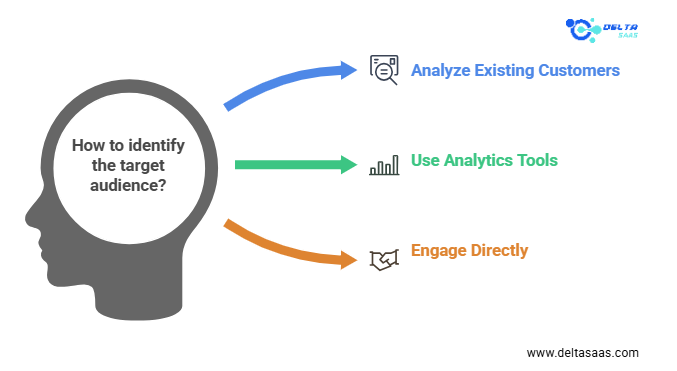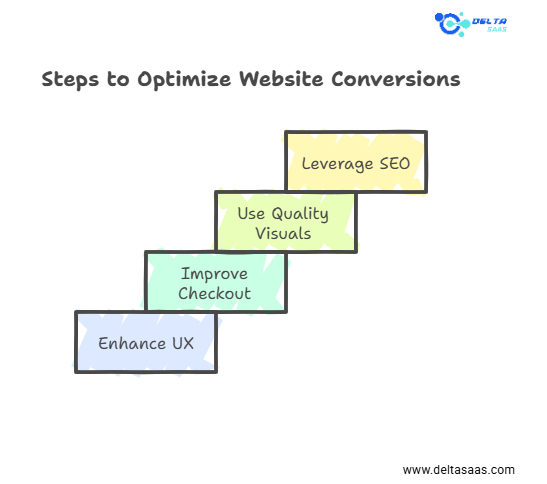
How to Make More Sales Online?
Increasing online sales is essential for business growth in today’s competitive digital market. Whether you run a small eCommerce store or a large online business, understanding the right strategies can help boost conversions, engage customers, and increase revenue. This guide explores proven tactics, from optimizing your website to leveraging social media and personalized marketing.

Know Your Audience and Refine Your Marketing Strategy
Before increasing sales, you need to understand your target audience deeply. Identifying their needs, preferences, and behaviors ensures you’re offering what they want—and presenting it in a way that resonates.
Identify Your Target Audience
Knowing your audience helps you create personalized marketing strategies that attract and convert potential buyers. Here’s how to define your audience:
- Analyze Existing Customers: Look at demographics, purchase history, and behaviors.
- Use Analytics Tools: Platforms like Google Analytics and Facebook Insights offer data on your audience’s location, age, and interests.
- Engage Directly: Send surveys or ask for feedback to understand what your customers value.
Example: If you sell fitness equipment, your audience might include health-conscious individuals aged 25–45 who value convenience and affordability.
Also Read,
Feedbeo Reviews: Transform Meetings with Interactive Live
Minimarks Reviews: Compact Bookmark Manager for Teams
Honest NodeLand Reviews – Features, Benefits & Pricing
Stepsy Reviews: Honest Insights on Features & Benefits!
Agiled Reviews: Discover Pros, Cons & Key Features!
Apipheny Reviews: Honest Insights Before You Buy
Bind AI Reviews: Honest Insights Before You Decide
Tailor Marketing Messages
Once you know your audience, create marketing campaigns that directly address their needs. Personalization increases engagement and drives sales.
- Email Marketing: Segment your email list to deliver tailored messages. For instance, send product recommendations based on past purchases.
- Dynamic Website Content: Show personalized product recommendations or promotions when visitors visit your site.
- Social Media Targeting: Use ads tailored to specific audience segments, such as age groups or interests.
Pro Tip: Use tools like Mailchimp or HubSpot to create and automate personalized email campaigns.
If you’re looking for the best software, check out Delta SaaS, which offers discounts and lifetime deals on SaaS products.

Optimize Your Website to Improve Conversions
Your website is your most powerful sales tool. A well-optimized site provides a seamless shopping experience, essential for converting visitors into customers.
Enhance Your Website’s User Experience (UX)
An easy-to-navigate website encourages visitors to stay longer and make purchases. Key aspects of a great UX include:
- Fast Loading Speeds: Ensure your website loads in under three seconds.
- Mobile Optimization: Over 60% of online shopping happens on mobile devices. Your site must be responsive and user-friendly on smaller screens.
- Intuitive Navigation: Make it easy for customers to find what they need. Use clear categories, a search bar, and well-organized product pages.
Improve Your Checkout Process
A complicated checkout process can lead to cart abandonment. Simplify it to encourage more sales.
- Offer Guest Checkout: Allow customers to make purchases without creating an account.
- Minimize Steps: Reduce the number of pages or fields customers must fill out.
- Provide Multiple Payment Options: Include popular payment methods like credit cards, PayPal, and digital wallets (e.g., Apple Pay).
Example: Shopify reports that businesses offering express checkout options like Shop Pay see higher conversion rates.
Read More: Best Ways to Increase Traffic to Your Website with Proven Methods
Use High-Quality Images and Videos
Visual content plays a huge role in online sales. Invest in professional images and videos that showcase your products.
- Show Multiple Angles: Let customers see all the details of the product.
- Demonstrate Usage: Use videos to show how the product works.
- Include Lifestyle Images: Help customers imagine themselves using your product.
Pro Tip: Platforms like Canva or Adobe Spark can help you create engaging visuals for your eCommerce store.
Leverage SEO to Drive Organic Traffic
Search Engine Optimization (SEO) is a cost-effective way to attract visitors to your online store. By ranking higher on Google and other search engines, you can reach potential buyers actively searching for your products.
Perform Keyword Research
Identify the terms your audience is searching for and integrate them into your content.
- Use tools like Ahrefs, SEMrush, or Google Keyword Planner to find relevant keywords.
- Target long-tail keywords like “Strong Building Customer Relationships for Success” or “Digital Marketing Tips for Small Business Success.”
- Incorporate keywords naturally into product descriptions, blog posts, and meta tags.
Optimize Your Content
SEO isn’t just about keywords—it’s also about creating high-quality, helpful content.
- Start a Blog: Publish articles that educate or solve problems for your audience. For instance, a fashion retailer could write about “10 Ways to Style a Summer Dress.”
- Use Descriptive Product Pages: Include keyword-rich descriptions that explain features and benefits.
- Optimize Alt Text: Add keywords to image alt text for better visibility in image searches.
Example: A pet supplies store could optimize for “best dog food for allergies” to attract pet owners searching for solutions.
Build Backlinks
Backlinks from reputable websites boost your site’s authority and improve rankings.
- Partner with Influencers: Get them to review your products and link to your site.
- Publish Guest Posts: Write articles for industry blogs with links to your store.
- Collaborate with Affiliates: Affiliates can help promote your store in exchange for commissions.
Pro Tip: Use tools like Moz or Ahrefs to monitor your backlink profile and identify opportunities for improvement.
Utilize Call-to-Actions (CTAs)
Your website’s CTAs should guide visitors toward making a purchase. Effective CTAs include:
- Add toCartt Now: Creates urgency.
- Claim Your Discount: Encourages users to take advantage of promotions.
- Subscribe and Save: Builds long-term customer relationships.
Harness the Power of Social Media
Social media platforms like Facebook, Instagram, and Pinterest are powerful tools for engaging audiences and driving sales.
Promote Products on the Right Channels
Not all platforms are created equal. Choose platforms where your target audience spends time.
- Instagram and Pinterest are great for visual industries like fashion, home decor, and food.
- LinkedIn: Ideal for B2B businesses targeting professionals.
- Facebook: Offers a broad reach and diverse audience for eCommerce stores.
Example: An eco-friendly beauty brand could showcase products using Instagram Reels and Stories to engage younger audiences.
Read More: Boosting Email Engagement: Proven Strategies for Success
Engage With Your Audience
Build trust by interacting directly with customers.
- Respond to Comments: Answer questions or thank users for their feedback.
- Host Live Events: Use Instagram or Facebook Live to demonstrate products or answer real-time questions.
- Run Polls and Contests: Encourage user participation to increase engagement.
Pro Tip: Use tools like Buffer or Hootsuite to schedule posts and track engagement metrics.
Run Paid Social Media Campaigns
Social media ads offer precise targeting to reach the right audience.
- Carousel Ads: Showcase multiple products in a single ad.
- Retargeting Ads: Target users who visited your website but didn’t complete a purchase.
- Video Ads: Use engaging videos to capture attention quickly.
Example: A fitness apparel store could run retargeting ads on Facebook offering discounts on items left in carts.
Key Takeaways:
- Understanding your audience is the foundation of increasing online sales.
- A seamless website experience, high-quality visuals, and a simplified checkout process boost conversions.
- SEO and social media are essential tools for driving traffic and engaging customers.
Read more: Email A/B Testing Mistakes to Avoid
Use Proven Tactics to Increase Online Sales Quickly
Once your foundation is solid, it’s time to implement proven strategies to maximize your sales. These tactics can help you boost revenue and conversion rates, from upselling to personalized email marketing.
Offer Discounts and Coupons
Everyone loves a good deal. Discounts and coupons create a sense of urgency and encourage customers to complete purchases.
Types of Promotions:
- First-Time Discounts: Offer a 10%–15% discount for new customers.
- Seasonal Sales: Run sales during holidays or peak shopping seasons.
- Limited-Time Offers: Create urgency with “24-hour flash sales” or “weekend-only deals.”
- Free Shipping: Offer free shipping for orders over a specific amount to increase the average order value.
Pro Tip: Use a pop-up on your site to offer a discount code in exchange for email signups.
Example: An online book retailer could offer a “Buy 2, Get 1 Free” promotion for back-to-school shopping.
Upsell and Cross-Sell Strategically
Upselling and cross-selling effectively increase the average order value without acquiring new customers.
- Upsell: Recommend premium versions of the product the customer is considering. For example, suggest a laptop with more storage or advanced features.
- Cross-Sell: Suggest complementary products. For instance, offer a phone case or headphones when someone buys a smartphone.
Where to Include Recommendations:
- On product pages: “Customers also bought…”
- In theCartt: “Complete your purchase with…”
- In follow-up emails: “Pair this with…”
Example: A skincare brand could suggest a moisturizer to customers purchasing a face cleanser.
Read More: Email Deliverability Issues: Causes & Fixes
Build a Customer Loyalty Program
Loyalty programs reward repeat customers and encourage them to buy from your store.
Benefits of Loyalty Programs:
- Increase Customer Retention: Loyal customers are more likely to return and make purchases.
- Encourage Higher Spending: Offer points for every dollar spent to incentivize larger purchases.
- Promote Referrals: Provide rewards for referring friends or family.
Examples of Loyalty Rewards:
- Discounts, free products, or exclusive access to new collections.
- Birthday rewards or early access to holiday sales.
Pro Tip: Use platforms like Smile.io or LoyaltyLion to set up a loyalty program seamlessly.
Example: A coffee subscription service could offer points for every order, which customers could redeem for free bags of coffee or exclusive blends.
Invest in Email Marketing
Email marketing remains one of the most effective tools for increasing online sales. It’s cost-efficient, measurable, and perfect for building lasting customer relationships.
Types of Emails to Send:
- Welcome Series: Introduce your brand to new subscribers with an exclusive offer.
- Abandoned Cart Emails: Remind customers of items left in their carts with a discount to encourage checkout.
- Product Recommendations: Suggest items based on past purchases or browsing history.
- Exclusive Offers: Share early access to sales or “VIP-only” discounts.
Pro Tip: Use segmentation to ensure your emails are relevant to specific customer groups. For example, send tailored emails to customers who purchased a particular category of products.
Example: An online shoe store could send an email offering a discount on matching accessories for a pair of boots previously purchased.
Read More: How to Improve Conversion Rate in Email Campaigns
Create a Sense of Urgency
Scarcity and urgency compel customers to act quickly. Highlighting limited-time deals or low stock levels can push hesitant buyers to complete their purchases.
Tactics to Create Urgency:
- Countdown Timers: Display on product pages or during checkout for flash sales.
- Low Stock Alerts: Show messages like “Only three left in stock!”
- Limited-Time Discounts: Promote “Today Only” offers to create urgency.
Example: An eCommerce clothing store could display a banner that says, “Hurry! 20% Off Ends in 12 Hours.”
Harness User-Generated Content (UGC)
User-generated content, like reviews, testimonials, or customer photos, builds trust and social proof. Shoppers are more likely to buy when they see others enjoying your products.
How to Collect and Use UGC:
- Ask for Reviews: Send follow-up emails requesting customers to leave product reviews.
- Encourage Social Sharing: Run a contest asking customers to post photos of your product using a branded hashtag.
- Feature UGC: Showcase reviews or customer photos on your website, email campaigns, or social media.
Example: A fitness brand could repost Instagram photos of customers wearing its workout gear and tag the users to encourage more participation.
Leverage Video Marketing
Videos are highly engaging and persuasive, making them an excellent tool for increasing sales. According to Wyzowl, 88% of marketers say video provides a high ROI.
Types of Videos to Create:
- Product Demos: Show how your product works and highlight its benefits.
- Customer Testimonials: Share success stories to build trust.
- Behind-the-Scenes Content: Humanize your brand by showing how your products are made or your team in action.
Platforms to Share Videos:
- YouTube for detailed demos.
- Instagram Stories and TikTok for short, engaging clips.
- Facebook Ads for targeted promotions.
Example: A cookware brand could create a video tutorial showcasing its pans being used to cook a gourmet meal.
Read More: How to Increase Click-Through Rate in Email Marketing: A Complete Guide
Run Retargeting Campaigns
Retargeting ads allow you to re-engage users who have visited your website but didn’t make a purchase.
Retargeting Strategies:
- Dynamic Ads: Show users products they viewed or left in theirCartt.
- Special Offers: Offer a discount to encourage a return visit.
- Personalized Messages: Create ads tailored to the customer’s browsing history.
Platforms for Retargeting:
- Facebook and Instagram Retargeting Ads.
- Google Display Network for remarketing campaigns.
Example: An online travel agency could retarget users with deals on the destinations they browsed.
Utilize Mobile Optimization
With most online shopping happening on mobile devices, optimizing your site for mobile users is no longer optional—it’s essential.
Mobile Optimization Tips:
- Responsive Design: Ensure your website looks great on any screen size.
- Click-to-Call Buttons: Make it easy for mobile users to contact you directly.
- Fast Loading Speeds: Compress images and minimize code to reduce loading times.
- Mobile-Friendly Payment Options: Enable payment options like Apple Pay, Google Pay, or PayPal.
Pro Tip: Test your site’s mobile performance using tools like Google’s Mobile-Friendly Test.
Example: A meal delivery service could streamline mobile checkout with an autofill feature for address and payment details.
Read More: Why Is Email Marketing Ineffective? Common Issues
Sustain Online Sales Growth with Long-Term Strategies
Boosting online sales isn’t just about short-term tactics; it’s about implementing sustainable strategies that ensure consistent revenue growth. This section will explore advanced methods like content marketing, customer retention, analytics, and leveraging new channels to maintain a thriving eCommerce business.
Publish High-Quality Content to Attract and Engage Customers
Content marketing is a long-term strategy that drives traffic, builds authority, and increases online sales. High-quality, informative, and engaging content encourages visitors to trust your brand and take action.
Types of Content That Drive Sales:
- Blog Posts: Write articles that solve problems for your audience. For example, a skincare brand could publish a blog titled “5 Tips to Prevent Dry Skin in Winter.”
- Product Guides: Create detailed buying guides to help customers make informed decisions.
- Case Studies: Share real-world examples of how your product has helped customers.
- Videos and Tutorials: Publish step-by-step guides or demonstrations to show how your product works.
Content Distribution Channels:
- Post blogs on your website and promote them via email or social media.
- Use YouTube for video content and Instagram for bite-sized clips.
- Repurpose content for multiple platforms (e.g., turn a blog into an infographic or a video).
Pro Tip: Focus on evergreen content that remains relevant over time to generate consistent traffic.
Build Trust Through Customer Reviews and Testimonials
Trust is one of the most icriticalfactors in increasing online sales. Showcasing customer reviews and testimonials can make hesitant buyers more confident in their purchase decisions.
How to Collect and Use Reviews:
- Ask for Reviews: Follow up with customers after their purchase and request feedback.
- Incentivize Reviews: Offer discounts or loyalty points in exchange for honest reviews.
- Feature Testimonials: Highlight positive reviews on product pages, landing pages, and social media ads.
Example: A SaaS company could display customer testimonials alongside measurable results, like “Our sales increased by 30% after using this software.”
Focus on Retaining Existing Customers
While attracting new customers is essential, retaining existing ones can be even more profitable. Repeat customers tend to spend more and cost less to market to.
Retention Strategies:
- Personalized Communication: Use customer data to send targeted emails, such as special offers for birthdays or anniversaries.
- Exclusive Perks: Give loyal customers early access to sales, free shipping, or bonus points in your loyalty program.
- Excellent Customer Support: Ensure fast, friendly, and efficient support through chat, email, or phone.
Pro Tip: Analyze your customers’ lifetime value (LTV) and focus on increasing it by nurturing long-term relationships.
Use Analytics to Refine Your Strategy
Data is the key to understanding what works and what doesn’t. You can make informed decisions to optimize your marketing strategies and increase online sales by analyzing your performance.
Metrics to Track:
- Conversion Rate: The percentage of visitors who make a purchase.
- Cart Abandonment Rate: The number of customers who add items to theirCartt but don’t complete checkout.
- Customer Acquisition Cost (CAC): How much does acquiring each new customer cost
- Bounce Rate: The percentage of visitors who leave your site without taking any action.
Tools to Use:
- Google Analytics: Track website traffic, user behavior, and conversion paths.
- Hotjar: Use heatmaps and session recordings to see where users drop off.
- CRM Platforms: Tools like HubSpot or Salesforce provide insights into customer behavior and segmentation.
Pro Tip: Regularly review analytics to identify trends and refine your strategies for maximum ROI.
Read More: Automated Email Marketing: Boost Campaign Success
Expand to New Channels for Greater Reach
Diversifying your sales channels helps you reach more customers and reduce dependency on any platform.
Channels to Consider:
- Marketplaces: Sell on Amazon, eBay, or Etsy to reach a larger audience.
- Social Commerce: Sell directly on social media platforms using Instagram Shops, Facebook Marketplace, or Pinterest Buyable Pins.
- Collaborate with Affiliates: Partner with affiliates to promote your products in exchange for a commission.
- Subscription Boxes: Offer subscription-based services for recurring revenue.
For example, the Aahandmade jewelry brand could list products on Etsy and sell through Instagram Sshops.
Implement Mobile-First Strategies
With mobile devices accounting for most online traffic, your business must prioritize mobile-friendly features to capture sales.
Mobile Optimization Tips:
- Ensure buttons and CTAs are easy to tap on small screens.
- Offer one-click payment options, such as Apple Pay or Google Pay.
- Simplify navigation with a clean, responsive design.
- Create mobile-friendly email campaigns with concise text and optimized images.
Pro Tip: Regularly test your website’s mobile experience to identify and fix potential issues.
Invest in Online Advertising
If you want quick results, online ads can drive targeted traffic to your store and increase sales. With tools like Google Ads or social media ads, you can reach customers actively looking for products like yours.
Types of Online Ads to Run:
- Search Ads: Appear at the top of Google search results for keywords like “brand-building strategies.”
- Social Media Ads: Use Facebook, Instagram, or TikTok to promote products with visual, engaging content.
- Display Ads: Target users with banner ads across websites they visit.
- Retargeting Ads: Remind visitors of products they viewed but didn’t purchase.
Example: A fitness equipment store could run Google Ads targeting keywords like “best home gym equipment.”
Build Partnerships to Expand Your Reach
Collaborating with complementary businesses or influencers can help you tap into new audiences and boost sales.
Partnership Ideas:
- Co-Marketing Campaigns: Collaborate with another brand to create a bundled offer.
- Influencer Collaborations: Partner with influencers to promote your products to their followers.
- Event Sponsorships: Sponsor virtual or in-person events that align with your brand’s values. For example, a meal-prepp company could collaborate with a fitness coach to promote healthy eating plans alongside workout programs.
Read More: Choosing Effective Newsletter Services for Your Business
Conclusion
Boosting online sales requires a combination of short-term tactics and long-term strategies. By knowing your audience, optimizing your website, leveraging social media, and focusing on customer retention, you can build a sustainable e-commerce business.
Whether you’re using email marketing, SEO, or upselling, the key is regularly testing, analyzing, and refining your approach. Start implementing these proven strategies today and watch your sales skyrocket!
FAQs: How to Make More Sales Online?
How can I increase sales on my website?
Optimize your website for mobile users, simplify the checkout process, and use high-quality images. Additionally, focus on SEO and run retargeting campaigns to bring back visitors who didn’t convert.
What is the quickest way to increase sales?
To quickly drive conversions, use tactics like running flash sales, offering discounts, retargeting ads, and leveraging email campaigns.
How can I increase online sales for my small business?
Focus on cost-effective strategies like email marketing, social media engagement, and optimizing your site for local SEO to reach nearby customers.
How do I boost sales on social media?
Use paid ads, influencer collaborations, and shoppable posts on platforms like Instagram and Facebook. Engage your audience with polls, contests, and live events.
What is the best method for selling online?
The best method combines SEO, email marketing, and social media to attract, engage, and convert potential customers.
How can I increase 100% sales?
Focus on upselling, cross-selling, offering discounts, improving customer retention, and expanding your marketing channels to double your sales.
What are unique ways to increase sales?
Try subscription-based services, user-generated content, referral programs, and partnerships to stand out and attract more customers.
How do I increase sales quickly without ads?
Offer flash sales, use email marketing, optimize your site for SEO, and build trust through customer reviews and testimonials.
What is the role of email marketing in increasing sales?
Email marketing nurtures leads, promotes discounts, reminds customers about abandoned carts, and builds loyalty with personalized communication.
How can I make more sales online for free?
Leverage organic methods like SEO, content marketing, social media engagement, and referral programs to increase sales without spending money on ads.


